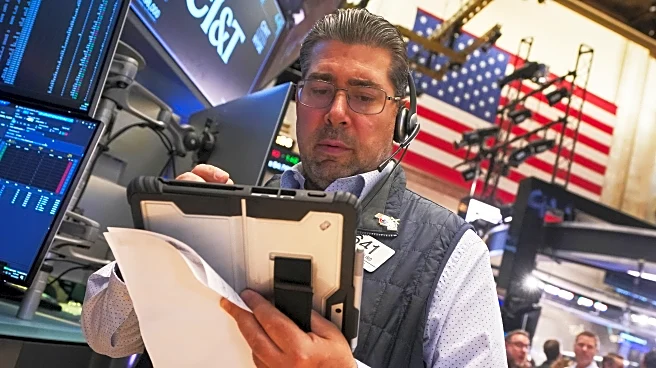What's Happening?
U.S. stock futures experienced a decline early Tuesday following a day of strong gains on Monday. Investors are preparing for a significant week of corporate earnings reports. Futures for the Nasdaq 100,
Dow Jones Industrial Average, and S&P 500 Index were down by 0.18%, 0.11%, and 0.13%, respectively, as of early morning on October 21. The previous day saw all three major indices close higher, driven by a surge in Apple stock and optimism regarding a potential end to the U.S. government shutdown. Additionally, U.S.-China trade tensions remain a focal point, with President Trump threatening 100% tariffs on Chinese imports starting November 1. However, his positive comments about a potential deal with China have somewhat alleviated concerns. The Q3 earnings season is in full swing, with companies like Netflix and Coca-Cola set to report on Tuesday, followed by Tesla on Wednesday. According to Bank of America, approximately 75% of S&P 500 companies have exceeded earnings estimates so far.
Why It's Important?
The movement in U.S. stock futures and the upcoming earnings reports are significant as they provide insights into the health of major corporations and the broader economy. The performance of tech giants, often referred to as the 'Magnificent 7,' is particularly noteworthy as they are expected to drive substantial earnings growth. This could influence investor sentiment and market dynamics. Additionally, the ongoing U.S.-China trade discussions and potential tariff implementations could have far-reaching implications for international trade relations and economic stability. The outcome of these negotiations may impact various sectors, including technology and manufacturing, which are heavily reliant on global supply chains.
What's Next?
Investors will be closely monitoring the earnings reports from major companies this week to gauge corporate performance and economic trends. The release of the consumer price index (CPI) data on Friday will also be pivotal, as it could provide insights into inflation trends and influence the Federal Reserve's monetary policy decisions. Market participants will be watching for any developments in U.S.-China trade talks, particularly any agreements or escalations in tariffs, which could affect market sentiment and economic forecasts.













